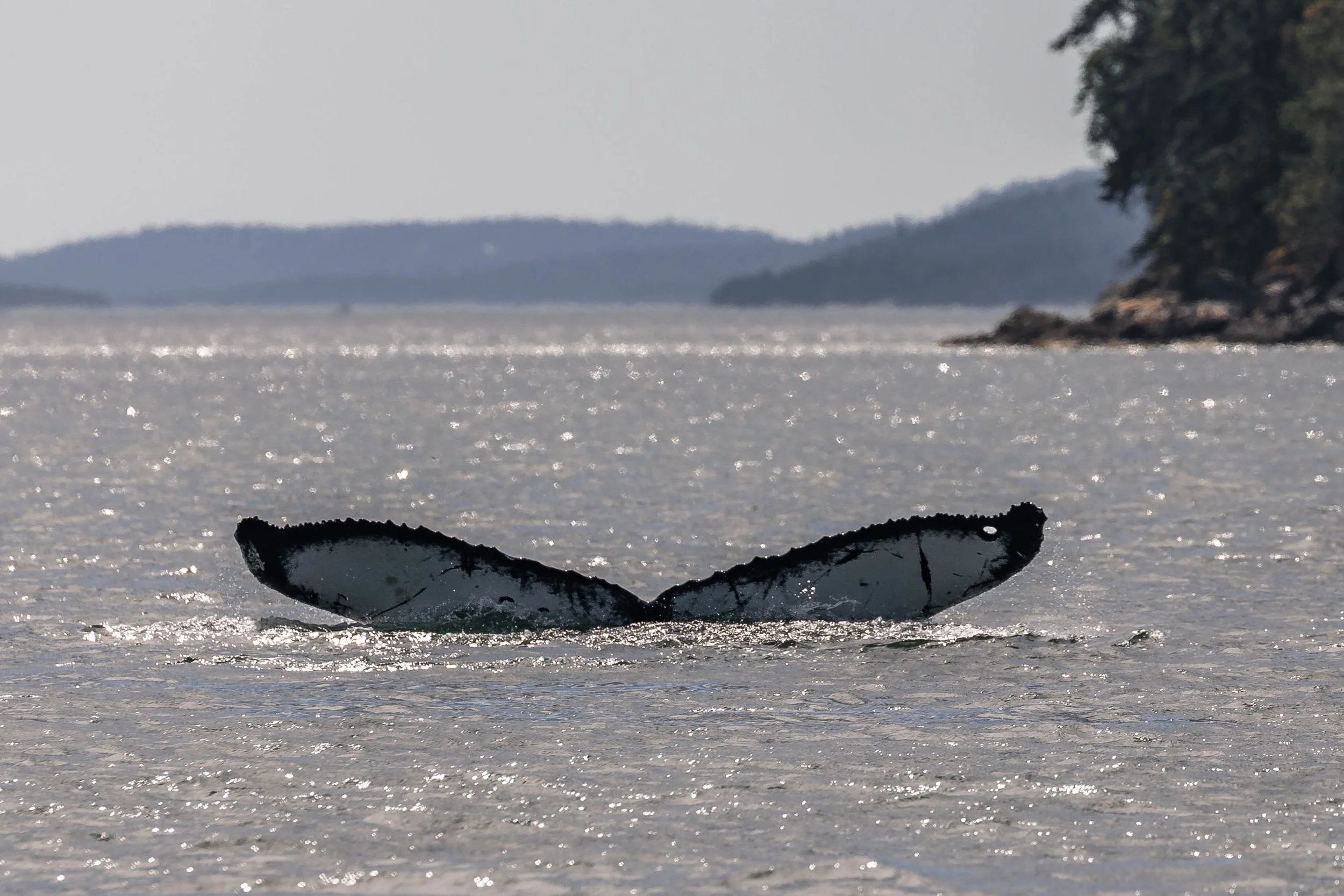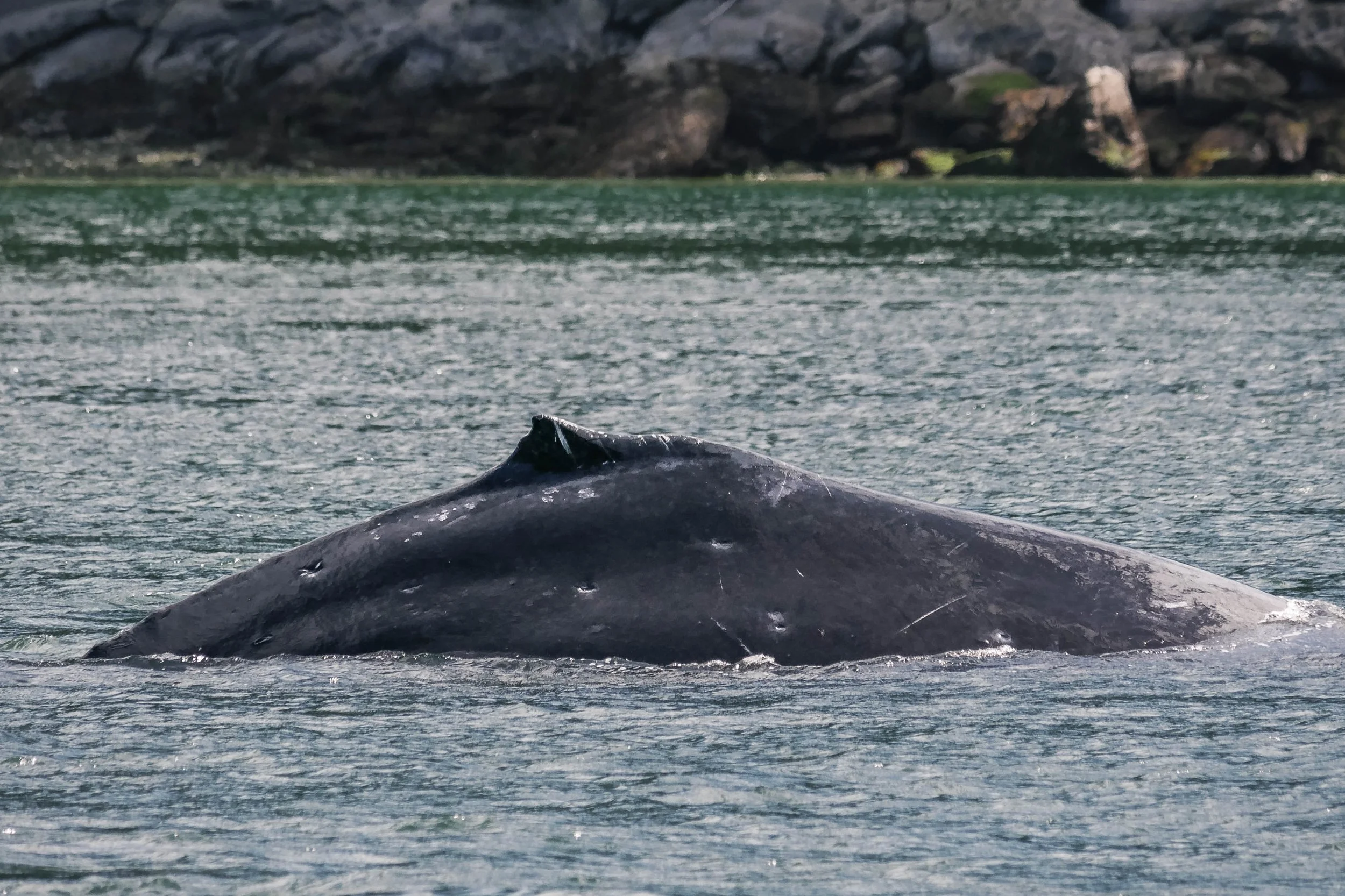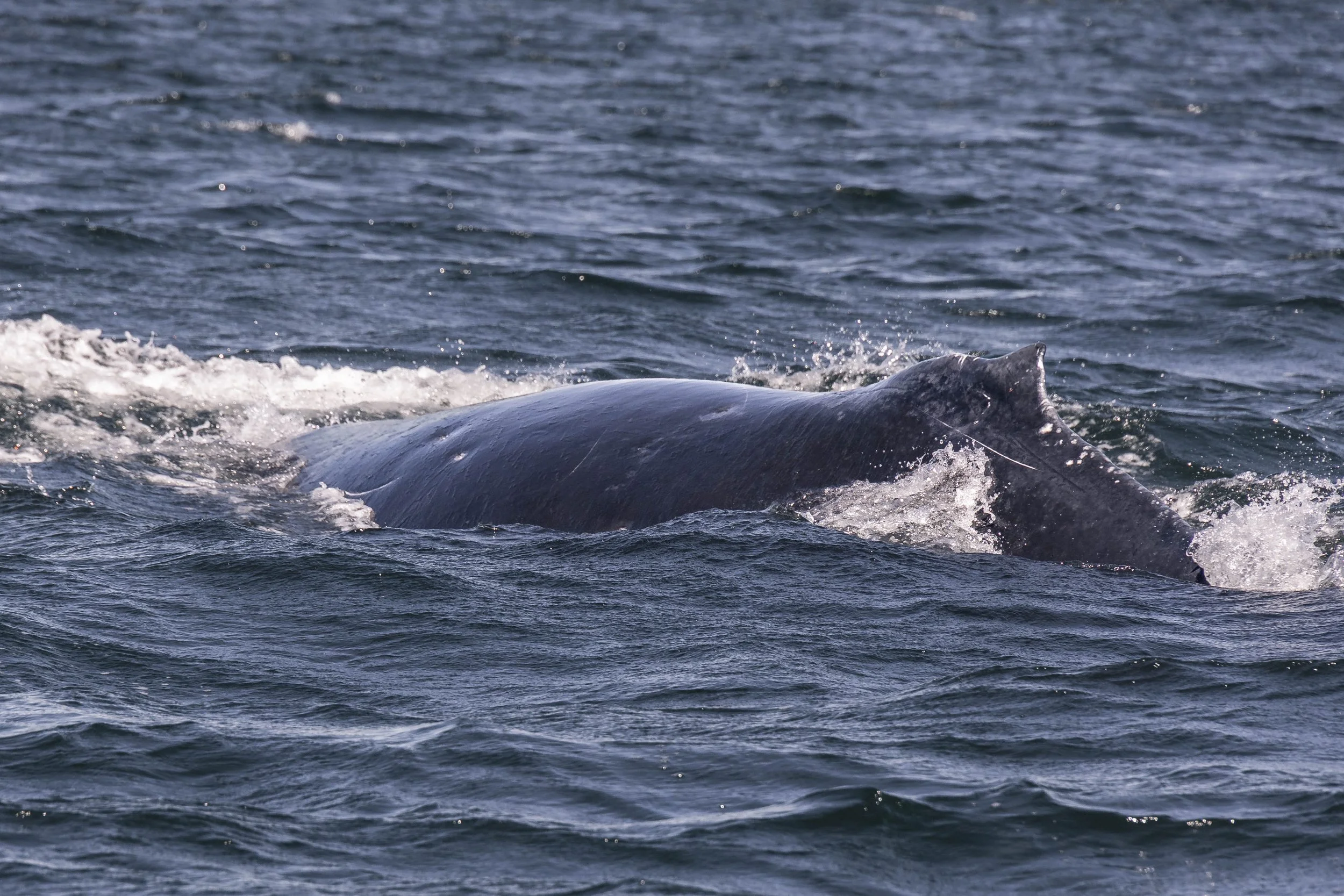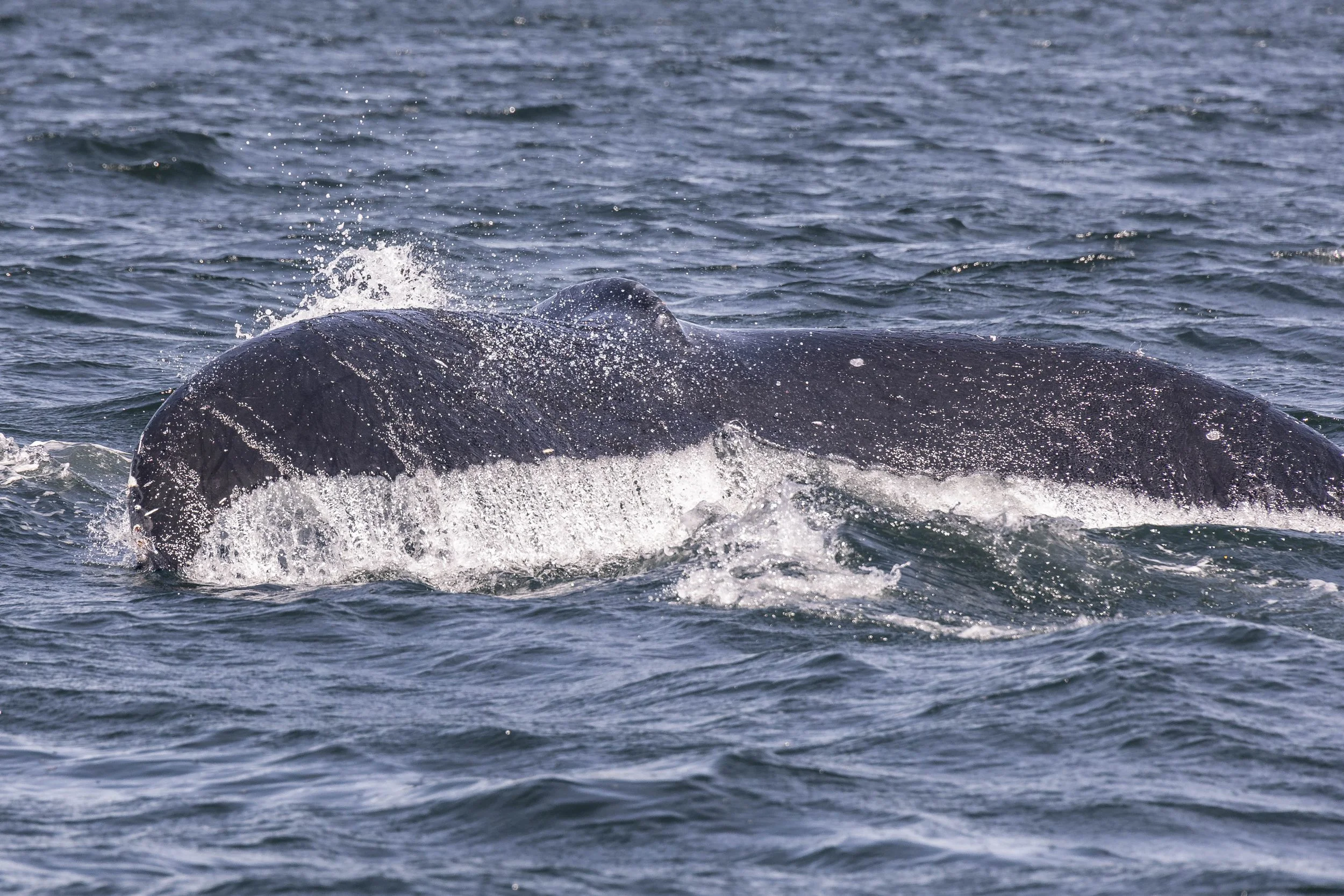July 13, 2025, 10:30 AM - Triple humpback time close to Dodd Narrows
The sun was shining as our full fleet set out for another fun-filled day on the water. With a bit of wind in the forecast, we decided to start the day’s search on the inside of the Southern Gulf Islands.
Poking through Dodd Narrows, the currents were roaring today as the boats crossed the tiny passage. Carefully navigating through the rapids, we continued onward, with our plan for the day to spread out inside the Gulf Islands to maximize our coverage. With the plan in mind, we began spreading out… when suddenly, our open vessel Keta saw a blow off of Round Island, just south of Dodd Narrows! This was the epitome of how we can find whales “right in our backyard”, as we were less than 15 minutes off our dock when we saw our first gentle giant of the day!
This little one was very quickly diving, inching very close to shore as we watched them. They have a very unique dorsal fin, and shortly after we began observing them, they dove, lifting their beautiful fluke high up into the air. This was the perfect chance for our Naturalists to snap a photo of this young humpback’s tail underside, which is the pattern we typically use to identify individuals. This pattern, with its dots, scratches, and white patches, is as unique to them as a fingerprint is to a human. Once we have a shot of their tail, we begin comparing it to our humpback catalogues, such as the Keta Coastal Conservation Catalogue (free download). After some comparing, the little humpback by Dodd Narrows was identified as Zephyr’s 2024 calf (BCZ0414 calf 2024).
This sighting is extra exciting, as this is the calf’s first year of life travelling without their mother. That first year can be dangerous, and, likely, many young whales do not survive it - but this little one has beaten the odds and seems to be doing well in our waters!
With its turbulent waters, Dodd Narrows can potentially be a great feeding spot as nutrients are brought up to the surface waters. However, due to the constant boat traffic, feeding in this area can also be highly dangerous for whales. Today’s encounter was a good reminder of why we always recommend anyone travelling by boat in our waters to follow the slogan “If you see a blow, Go Slow” - whales can surface unexpectedly, and it’s much easier to divert as needed if you are traversing slowly instead of zooming by!
After observing Zephyr’s calf for a bit, we headed out, eyes always searching for more wildlife. A couple of our vessels popped out into the Strait of Georgia, expanding the search area a bit more. They coasted down to Stinky Rocks, a small rocky group of islands where our pinnipeds haul out. Here, our Steller Sea Lions were grumbling away, soaking up the rays and enjoying the occasional splash from the waves. While there were tons of rocks above the waterline due to the tide being very low, the sea lions were all piled on top of each other at the far southern tip of the island. It is always a funny sight to see, as sea lions are very territorial, but they always clump up together instead of sprawling out so every individual could have their own bit of rock.
A bit closer to Valdez Island was a different type of pinniped (fin-footed mammal), snoozing the day away - our Harbour Seals! Our Harbour Seals are referred to by many nicknames, but one of the most common nicknames you may hear around here is “Rock Sausages”. This name seemed pretty apt during our encounter, as they roasted away in the sun’s rays. Harbour Seals live relatively sedentary lifestyles, and can spend upwards of 10-11 hours every day napping, so sleeping is one of the most commonly showcased behaviours we see while on tours.
The search continued after we departed the pinnipeds, always scanning the horizon for more tails, blows, or dorsals. After a bit of searching, our open vessel Cascadia located more humpbacks once again inside the Gulf Islands - apparently, this was the place to hang out today!
These two were zipping along, quickly travelling northbound, back towards where we had seen Zephyr’s 2024 calf earlier. These two were doing very fast surfaces, but thanks to a couple of flukes from them and some photos of their dorsals to use for cross-referencing, we identified these two as Snoopy (BCY0770) and Bandit (BCX2081). Snoopy is a regular in our area, with sightings of him almost every year. Bandit, however, isn’t as commonly sighted, with all of our sightings of them being from either this year or last year. This young whale is the 2020 calf of Raccoon, another semi-regular whale in our area (can you see how the calf got its name?). These two potentially could have been busily travelling to meet up with Zephyr’s calf, as they were going very fast the entire time we observed them.
Soon our time with the whales was up, and we had to say our goodbyes, heading back north, back through Dodd Narrows and starting our way back to home port.
Please enjoy these photos by Marine Naturalists Hayleigh Hilbert, Cheyenne Brewster, and Jordan Robinson!
Zephyr’s 2024 calf zooming down for a dive. Photo by Hayleigh Hilbert.
Zephyr’s 2024 calf has a very unique fluke, with many scratches and nicks, and a big hole on the one side! Photo by Hayleigh Hilbert.
Making a splash! Photo by Cheyenne Brewster.
Zephyr’s 2024 calf’s dorsal fin. Photo by Cheyenne Brewster.
Zephyr’s 2024 calf’s blowholes as they crash through the waters. Photo by Jordan Robinson.
Look at all that unique dorsal scarring! Photo by Jordan Robinson.
A fluke waterfall. Photo by Jordan Robinson.
What a beautiful fluke! This is Zephyr’s 2024 calf. Photo by Jordan Robinson.
Snoopy fluking and diving. Photo by Jordan Robinson.
The very tip of Bandit’s fluke. Photo by Cheyenne Brewster.
Snoopy cruising by. Photo by Hayleigh Hilbert.
Snoopy beginning to dive. Photo by Hayleigh Hilbert.
Flukes up with Snoopy! Photo by Hayleigh Hilbert.
Snoopy also has a very unique fluke. Photo by Hayleigh Hilbert.
Harbour Seals balanced on the rocks at Round Island. Photo by Jordan Robinson.
Snoozing in the sunshine. Photo by Hayleigh Hilbert.
Nice and cozy over on Stinky Rocks. Photo by Cheyenne Brewster.
Side eye from a sea lion as they contemplate where to nap. Photo by Hayleigh Hilbert.
Meandering along the top of Stinky Rocks. Photo by Cheyenne Brewster.



















